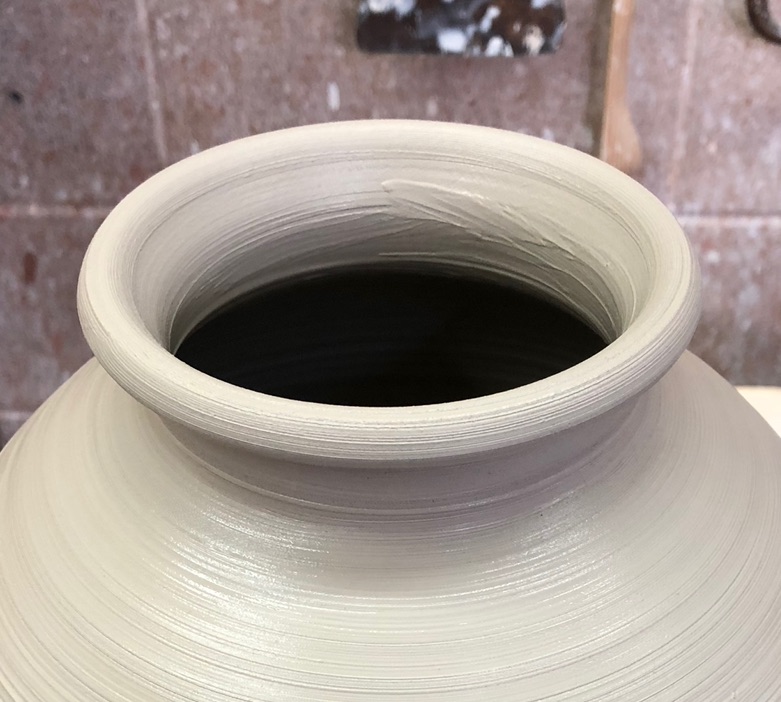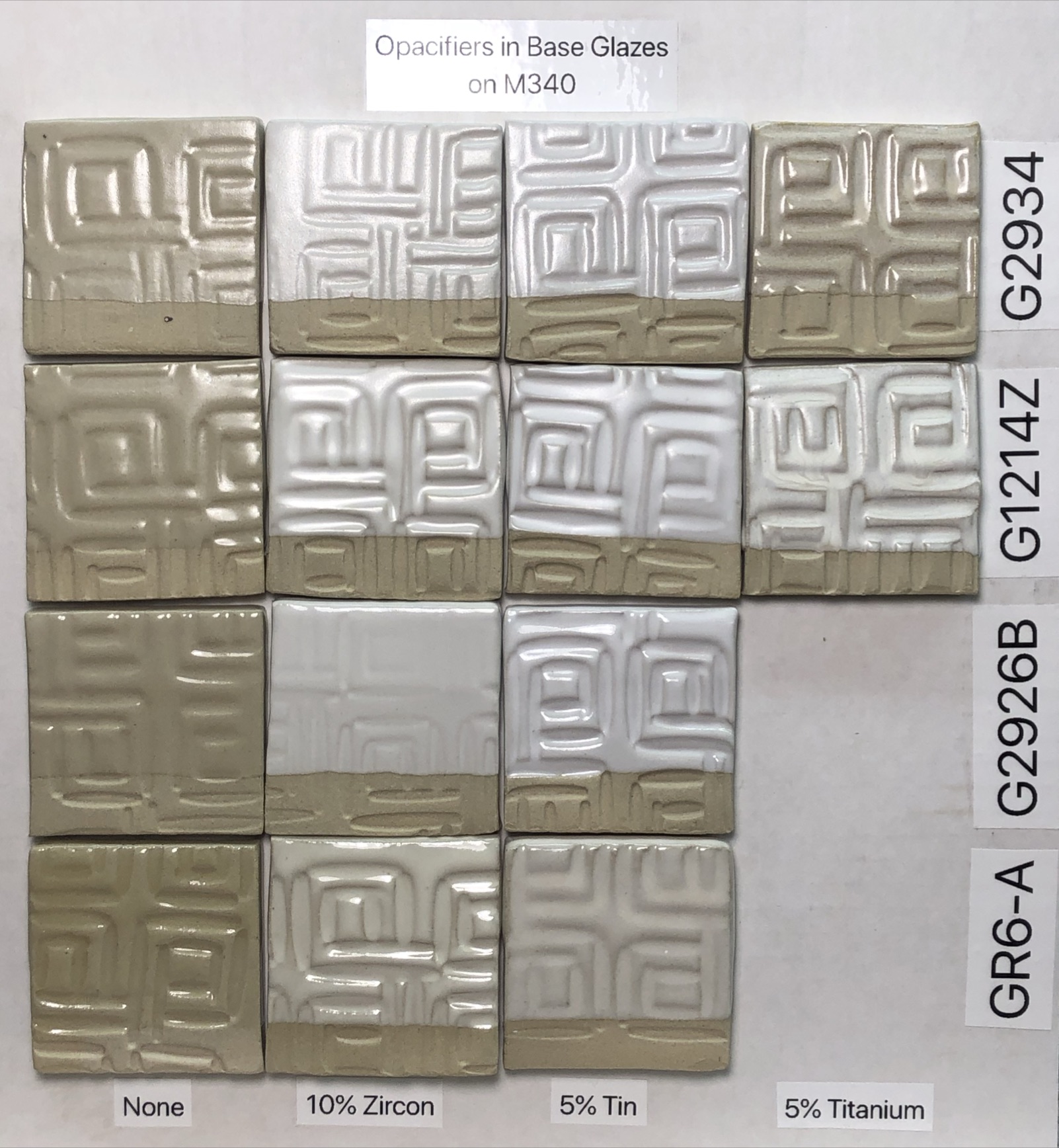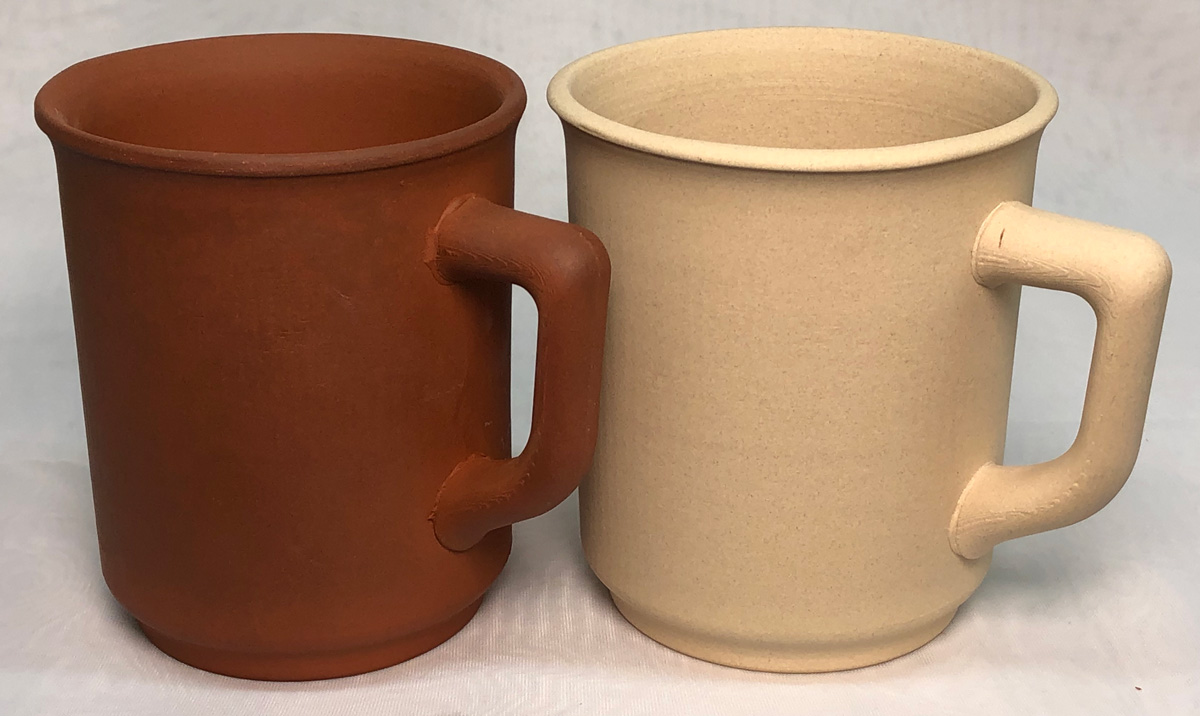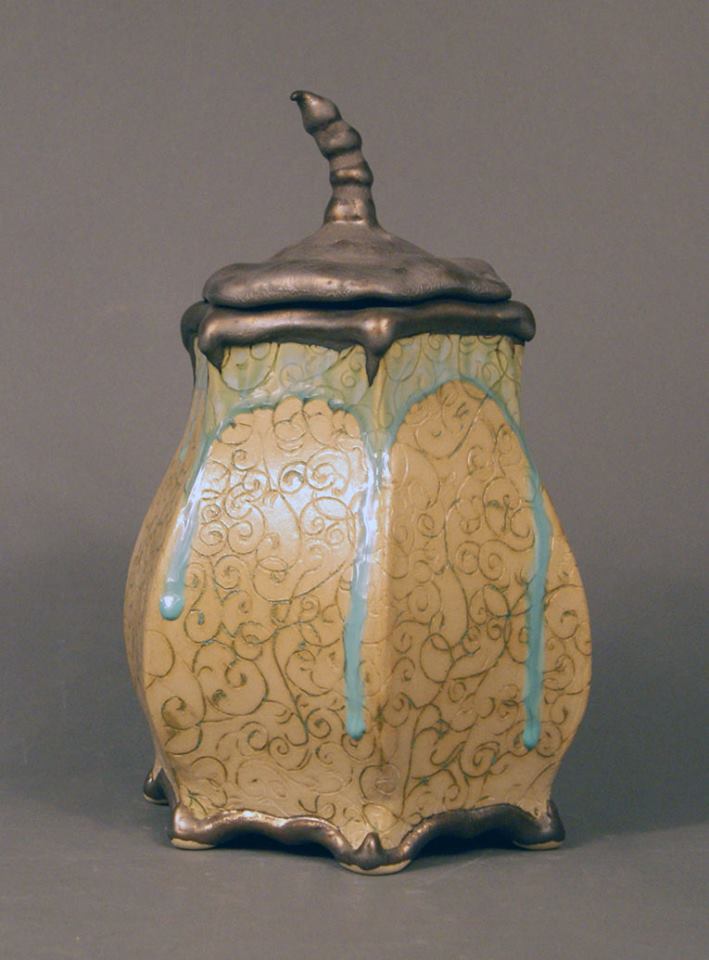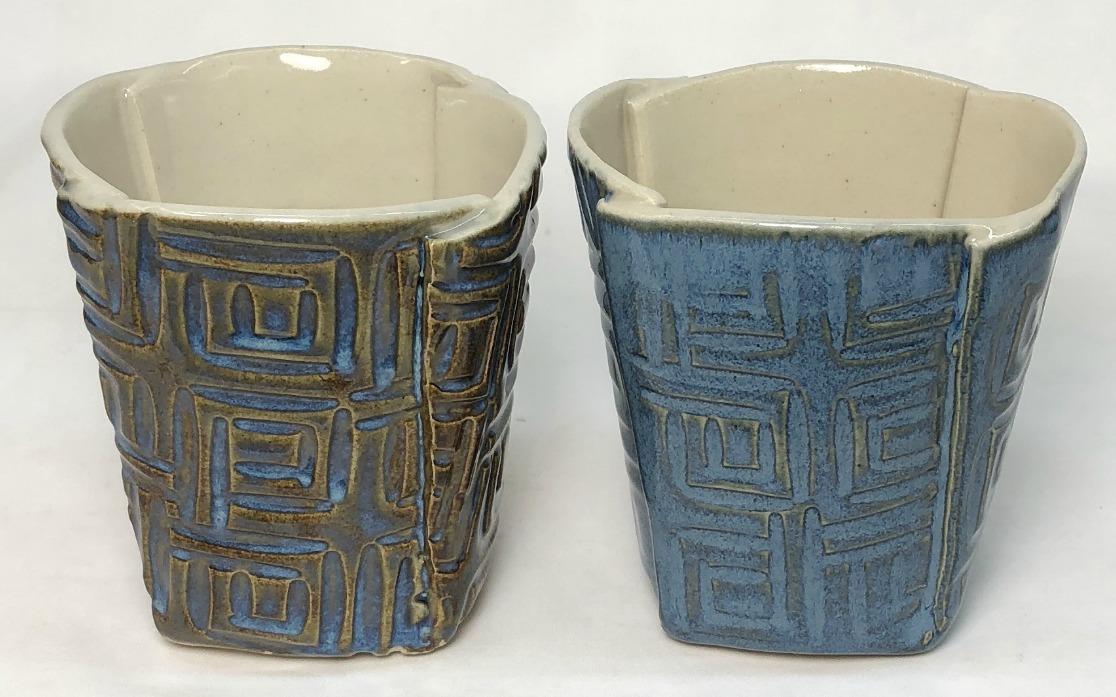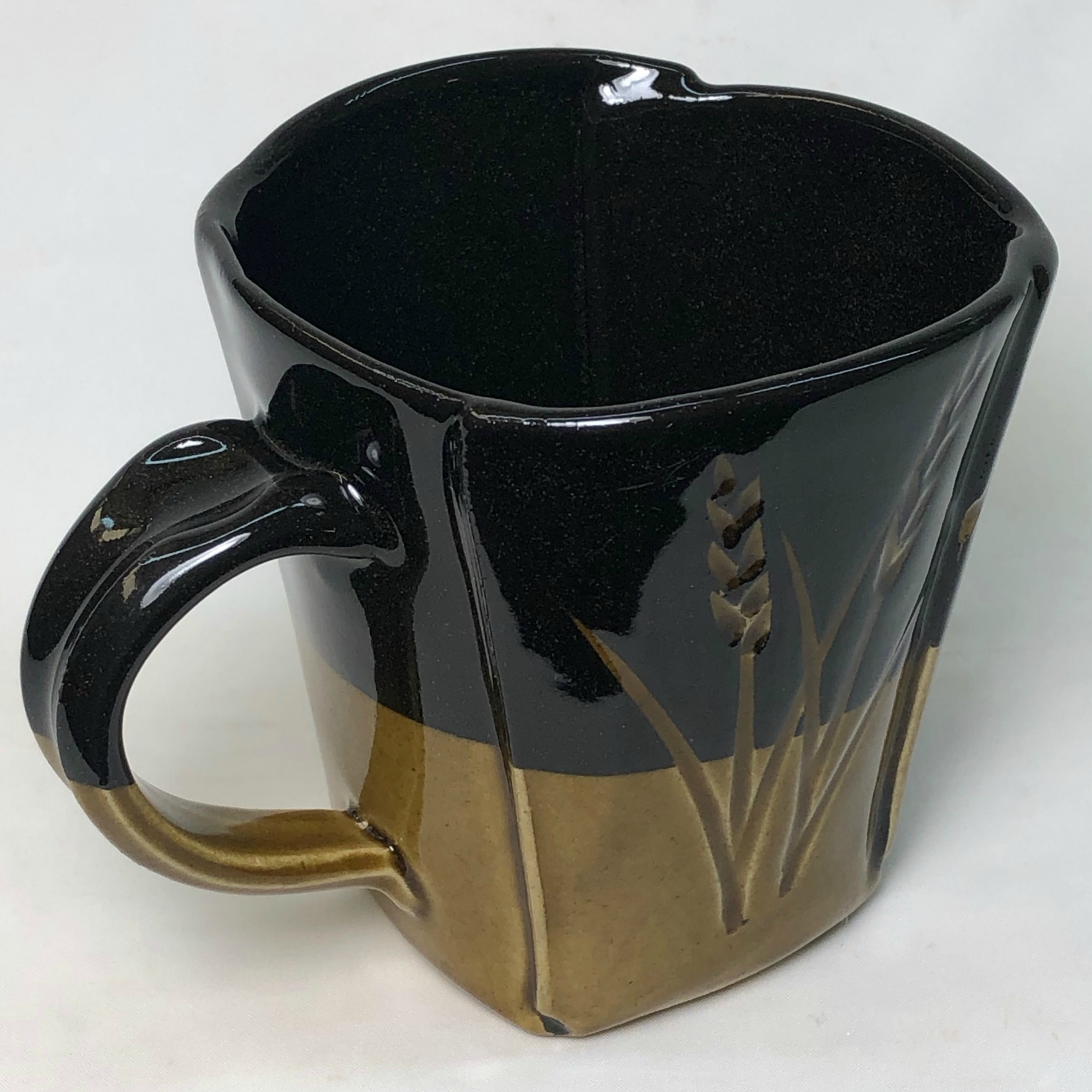M340
Description
Our most popular mid-temperature, smooth, plastic, semi-vitreous, buff burning, native functional stoneware.
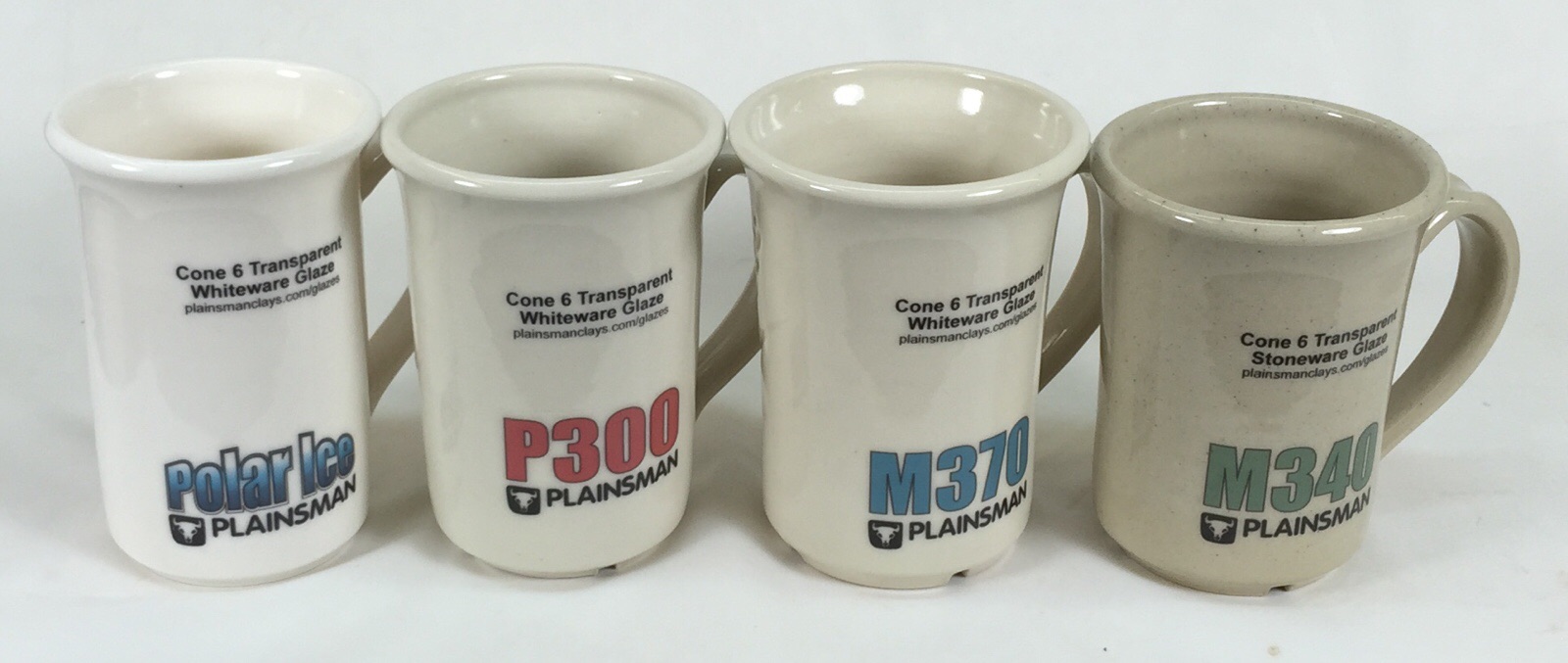
Plainsman Polar Ice, P300, M370 and M340 with G2926B Whiteware transparent glaze on the porcelain (G2916F Stoneware transparent on the M340).
The M340 is made from a combination of our A3 and B stoneware materials (as are H550, Buffstone and L212). It is our most popular body (widely used in schools, by hobbyists, and professional potters. Compared to bodies made from refined industrial minerals, M340's diversity of ultimate particle sizes produces a body of much higher dry strength. Its parent materials are also highly consistent, pure, and free of foreign particles. In fact, even without grinding, 95% of a raw sample of M340 will wash through a 200 mesh sieve.
News
Jan 2023: M340 is more vitreous than in the past (porosity can go as low as 0.5% at cone 6). This will be a benefit to most users, producing stronger and more functional ware. However, for some susceptible shapes it can mean more warping during firing. Because our 3B native clay became more vitreous in a mining we recently began using, it was necessary to remove all the talc from the M340 recipe. But even that was not enough to bring it into line with the normal target of 1.5% porosity at cone 6. A recipe adjustment is being tested and more information will be coming soon.
Process Properties
M340 has medium plasticity and feels smooth (having a slight texture).
There is some distribution of particle sizes in the plus 200 mesh range, these provide channels for faster drying than other bodies you may have used. You should have few problems drying smaller pieces, but care and attention are necessary when making larger pieces, especially flat plates, shallow bowls and sculptural ware. Make sure that the focus is on the evenness of drying rather than speed; if sections of a piece dry faster, then either slow these sections down or slow down the drying of the entire piece to effect a more even process.
Firing
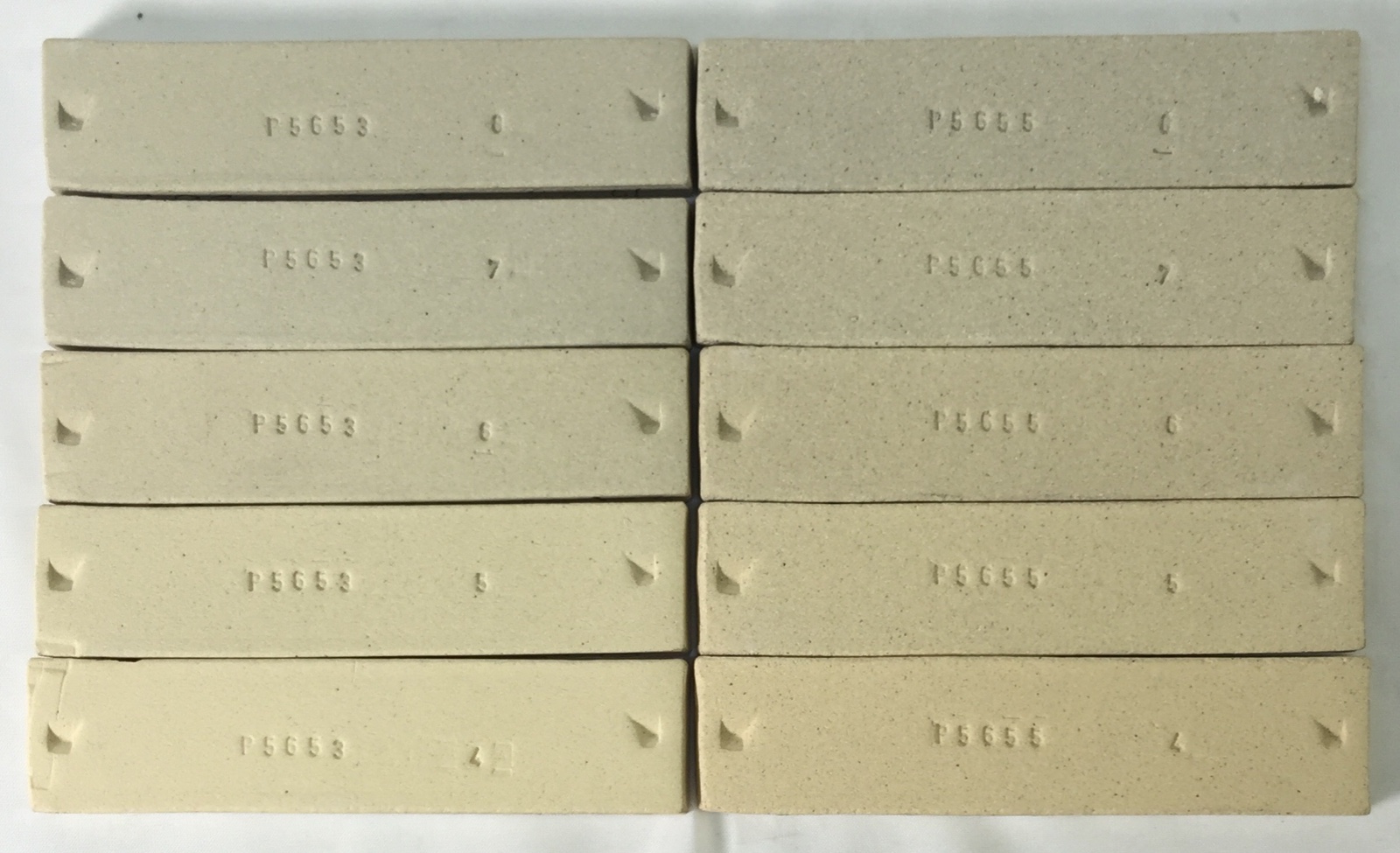
Fired test bars of M340 (left) and M325. Fired at cone 8, 7, 6, 5 and 4 (top to bottom). M340 has a more pronounced color shift (from straw to grey) between cone 5 and 6 than M325 does. This indicates vitrification is beginning.
M340 fires from a straw color at cone 4 to stone-grey-buff at cone 6 to grey by cone 8. It is best used at cone 6. Verify that firings-by-controller are not over-firing (e.g. cone 7) or pieces could warp.
On longer firings the size and population of fired specks will increase, especially if the kiln is poorly ventilated.
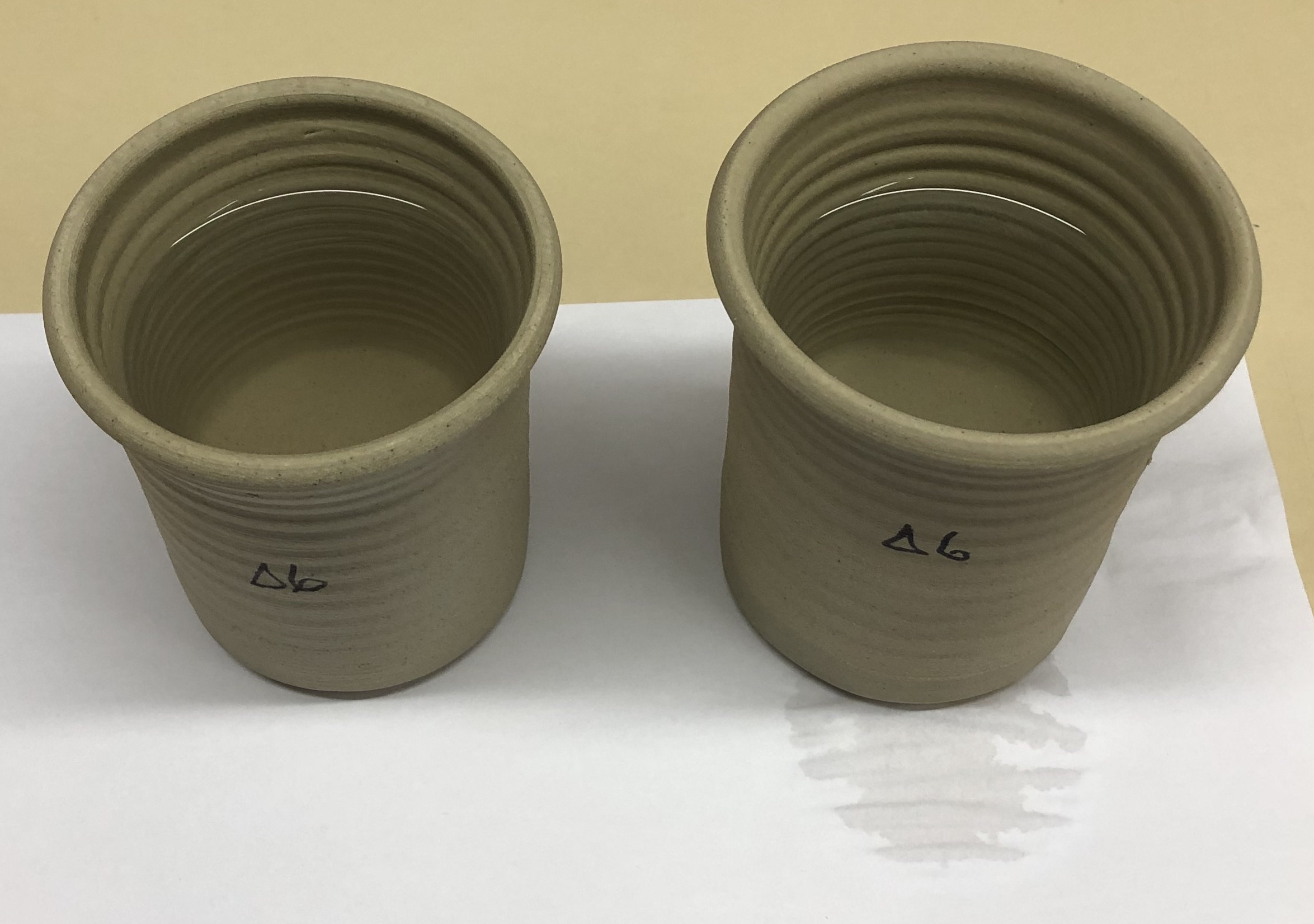
The M340 unglazed mug on the right has 2.5% porosity at cone 6, that means water can eventually pass through (as shown in this 24-hour test on a piece of paper). The left piece is a custom body made from 3D, it has 1% porosity as does not leak. The point: A non-crazing glaze is needed for water tight ware.
To get the best defect-free surface please consider using a drop-and-hold firing schedule, for example the PLC6DS schedule. If crystallization during cooling is not an issue, glazes will give optimum results if slow-cooled also (e.g. the C6DHSC schedule).
Glazing
M340 is high in silica and will craze fewer glazes than porcelains. However, crazing is possible if a glaze is high in sodium (i.e. from soda feldspar or nepheline syenite) or very low in SiO2 or Al2O3 (little clay or silica). For functional ware check glaze-fit using a boiling water:ice water immersion test.
Since M340 does contain some iron oxide, brightly colored glazes will be muted compared to porcelain. This can be handled by using a well-fitted white engobe, like L3954B, between body and glaze (or opacifying the glaze more).
Glaze Recipes
Commercial brush-on glazes: They may or may not fit our clays (check for glaze fit using a BWIW test or similar). For brightly colored glazes (especially with layering) do a leach test (e.g. GLLE test). Consider using a transparent or white liner glaze for food surfaces.
Crazing: Functional ware must remain craze-free (crazing is unsanitary and drastically reduces ware strength). Even though ware may not be crazed out-of-the kiln it may do so with time. Do cycles of a boiling water:ice water immersions (BWIW test) on a piece to test glaze fit (by stressing it to bring out any crazing or shivering tendencies).
Thixotropy: If you want the best application properties for one-coat dipping, consider creating a thixotropic slurry. Thixotropic glazes are creamy because they have been thinned and then gelled by the addition of a flocculant.
This body is a great candidate for the engobe process, we recommend the L3954B recipe. It can be colored with stains or whitened with zircopax. It can be applied thickly as an engobe or thinly as a slip.
DIY brushing glazes and dipping glazes: Begin with good transparent base recipes that do not craze, cutlery mark or leach on the body. Our G2926B glossy and G2934 matte can be purchased as powders or weighed out from their recipes (both can be adjusted for glaze fit). The two can be mixed to fine-tune matteness (e.g. 15:85 matte:gloss mix gives us a silky matte). Stains, opacifiers and variegators can be added to make almost any effect. Consider also making glazes based on GA6-A and GR6-A.
Casting Recipe
M340 has soluble salts that prevent the action of deflocculants (rather than thin out, an M340 slurry will turn into a gel in response to additions of Darvan or sodium silicate). We have developed a casting body that is of similar color and maturity (made from refined materials), code numbered L3798G. We do not produce this as a product, but you can mix it yourself. It is important to understand the principles of deflocculation, be able to measure specific gravity efficiently and have a good propeller mixer to make good casting slip.
Thermal Expansion
We do not supply thermal expansion values. If a chart is supplied here, please view it only as a way to compare one body with another. Please note that, although you may calculate the thermal expansion of a glaze, this cannot be done for clay bodies since they do not melt. The best way to fit glazes to clay bodies is by testing, evaluation, adjustment and retesting. For example, if a glaze crazes, adjust its recipe to bring the expansion down, fire a glazed piece and thermal stress it (using an IWCT test, 300F into ice-water). If it still crazes, repeat the process.
Physical Properties
Drying Shrinkage: 6.0-7.0% Water Content: 20.0-21.5% Drying Factor: C120
Sieve Analysis (Tyler mesh):
+48: 0.0-0.1% 48-65: 0.4-0.8 65-100: 1.5-2.5 100-150: 1.5-2.5 150-200: 4.0-6.0
Fired Shrinkage:
Cone 4: 4.5-5.5% Cone 5: 4.7-5.3 Cone 6: 5.0-5.5 Cone 7: 5.5-6.0
Fired Absorption:
Cone 4: 3.5-4.5% Cone 5: 1.5-2.5 Cone 6: 0.5-1.5 Cone 7: 0.2-0.7
Chemical Analysis
CaO 0.2 K2O 2.1 MgO 1.2 Na2O 0.1 TiO2 0.6 Al2O3 17.7 P2O5 0.0 SiO2 69.2 Fe2O3 1.4 MnO 0.0 LOI 7.5%
Gallery
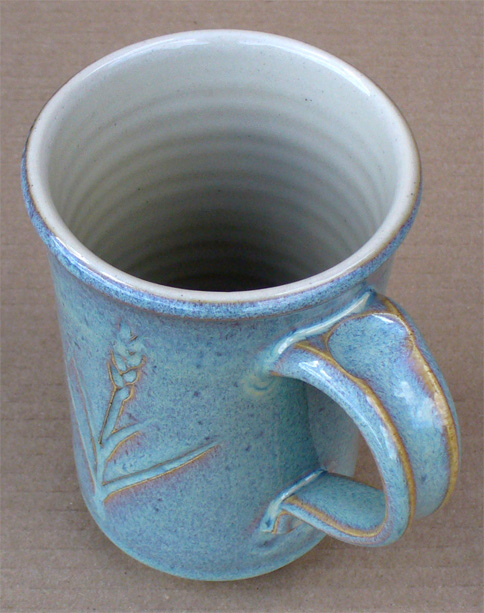
This M340 mug has GA6-C Alberta Slip rutile blue (outside) and GR6-C Ravenscrag white liner glaze (Ravenscrag base plus opacifier). By Tony Hansen.
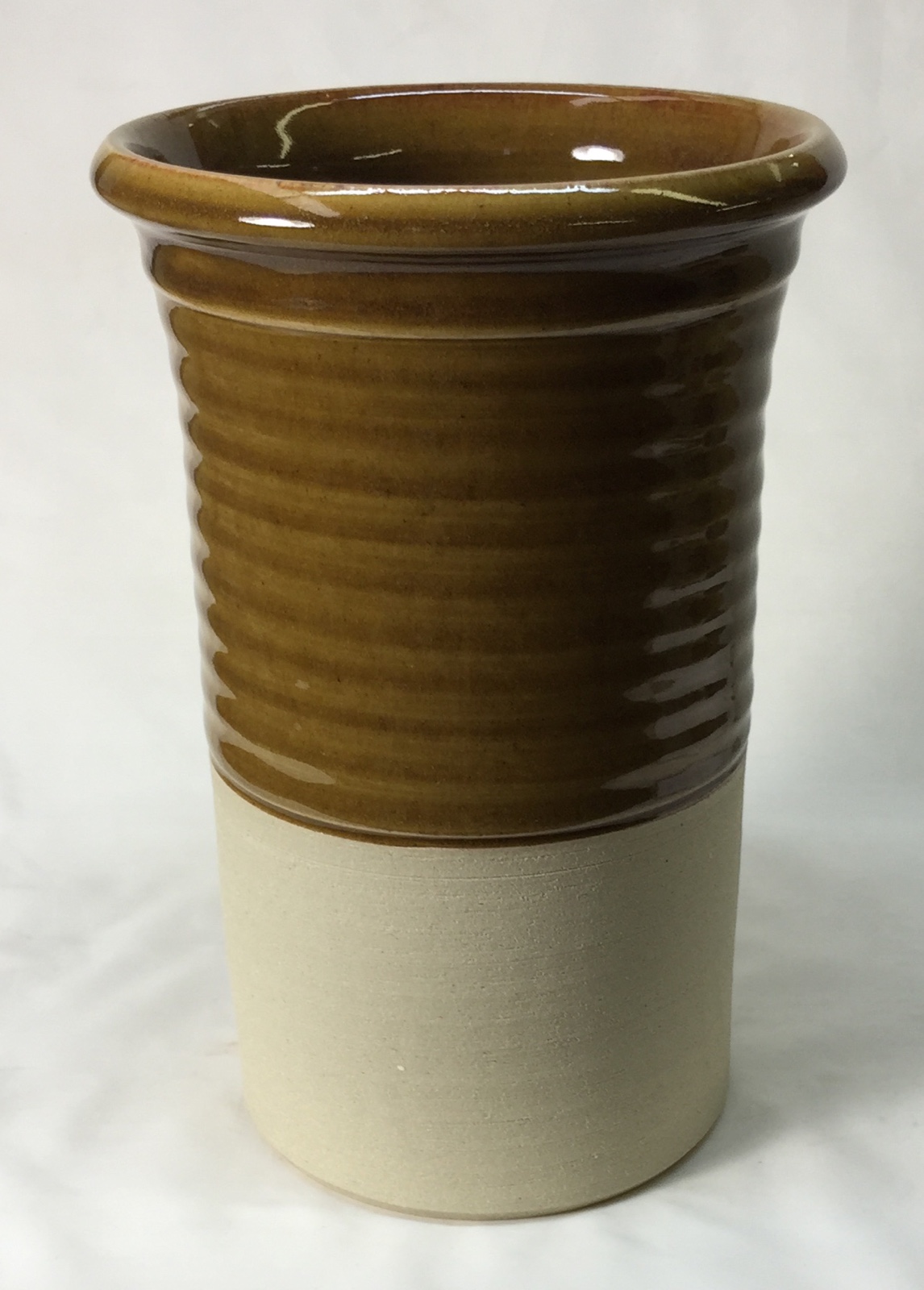
M340 with GA6-B base Alberta Slip glaze (employs frit 3195 instead of 3134). A slow cool produces a flawless surface.
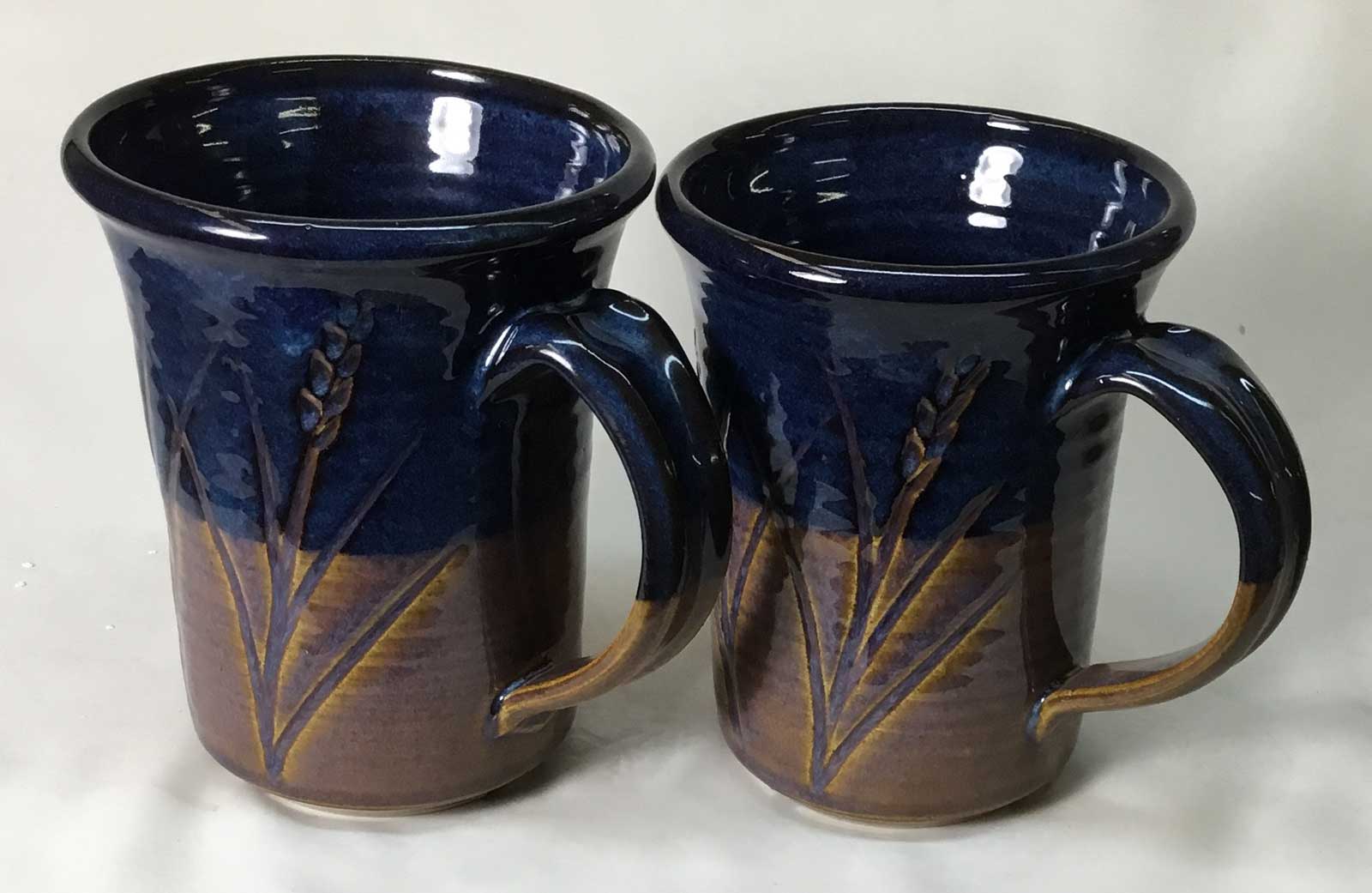
A very deep and rich blue (with no cobalt). This is M340 fired to cone 6. Black-firing L3954B engobe (having 10% Burnt Umber instead of the normal 10% Zircopax) was applied inside and partway down the outside (at the stiff leather hard stage). The incising was done after the engobe dried enough to be able to handle the piece. The glaze is GA6-C Alberta Slip rutile blue.
